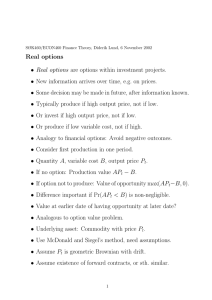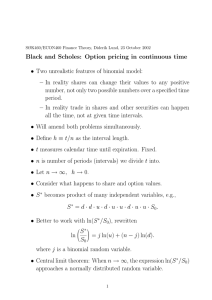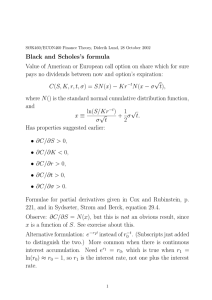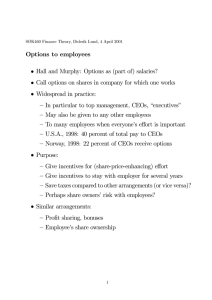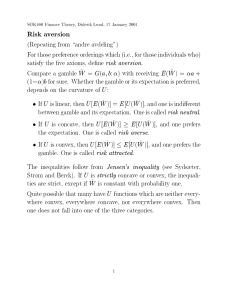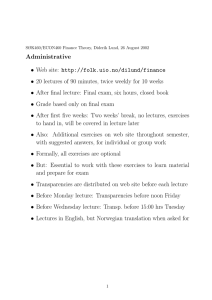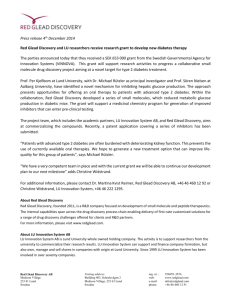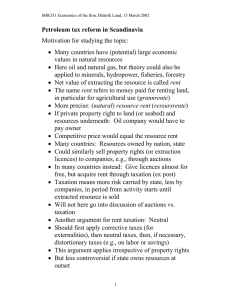The “mean-variance” approach Much of elementary finance theory assumes:
advertisement
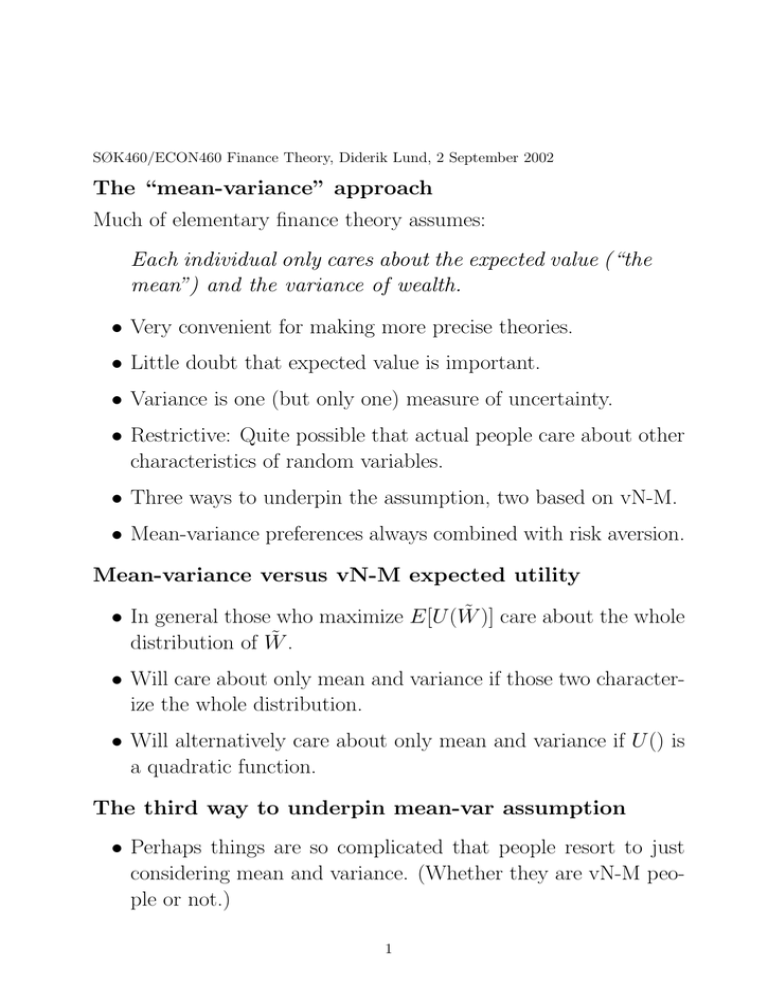
SØK460/ECON460 Finance Theory, Diderik Lund, 2 September 2002
The “mean-variance” approach
Much of elementary finance theory assumes:
Each individual only cares about the expected value (“the
mean”) and the variance of wealth.
• Very convenient for making more precise theories.
• Little doubt that expected value is important.
• Variance is one (but only one) measure of uncertainty.
• Restrictive: Quite possible that actual people care about other
characteristics of random variables.
• Three ways to underpin the assumption, two based on vN-M.
• Mean-variance preferences always combined with risk aversion.
Mean-variance versus vN-M expected utility
• In general those who maximize E[U (W̃ )] care about the whole
distribution of W̃ .
• Will care about only mean and variance if those two characterize the whole distribution.
• Will alternatively care about only mean and variance if U () is
a quadratic function.
The third way to underpin mean-var assumption
• Perhaps things are so complicated that people resort to just
considering mean and variance. (Whether they are vN-M people or not.)
1
SØK460/ECON460 Finance Theory, Diderik Lund, 2 September 2002
Mean-var preferences due to distribution
• Assume that choices are always between random variables with
one particular type (“class”) of probability distribution.
• Could be, e.g., choice only between binomially distributed variables. (There are different binomial distributions, summarized
in three parameters which uniquely define each one of them.)
• Or, e.g., only between variables with a chi-square distribution.
Or variables with normal distribution. Or variables with a lognormal distribution.
• Some of these distributions, such as the normal distribution and
the lognormal distribution, are characterized completely by two
parameters, the mean and the variance.
• If all possible choices belong to the same class, then the choice
can be made on the basis of the parameters for each of the
distributions.
• Example: Would you prefer a normally distributed wealth with
mean 1000 and variance 40000 or another normally distributed
wealth with mean 500 and variance 10000?
2
SØK460/ECON460 Finance Theory, Diderik Lund, 2 September 2002
• If mean and variance characterize each alternative completely,
then all one cares about is mean and variance.
• Most convenient: Normal distribution, since sums of normally
distributed variables are also normal. Most opportunity sets
consist of a lot of alternative sums of variables.
• Problem: Positive probability for negative outcomes. Share
prices are never negative.
3
SØK460/ECON460 Finance Theory, Diderik Lund, 2 September 2002
Mean-var preferences due to quadratic U
Assume
U (w) ≡ −aw2 + bw + c
where a > 0, b > 0, c are constants. With this U function:
E[U (W̃ )] = −aE(W̃ 2) + bE(W̃ ) + c
= −a{E(W̃ 2) − [E(W̃ )]2} − a[E(W̃ )]2 + bE(W̃ ) + c
= −a var(W̃ ) − a[E(W̃ )]2 + bE(W̃ ) + c,
which is a function only of mean and variance of W̃ .
Problem: U function is decreasing for large values of W . Must
choose a and b such that those large values have zero probability.
Another problem: Increasing (absolute) risk aversion.
4
SØK460/ECON460 Finance Theory, Diderik Lund, 2 September 2002
Indifference curves in mean-stddev diagrams
• If mean and
√ variance are sufficient to determine choices, then
mean and variance are also sufficient.
• More practical to work with mean (µ) and standard deviation
(σ) diagrams.
• Common to put standard deviation on horizontal axis.
• Will show that indifference curves are increasing and convex in
(σ, µ) diagrams.
• Consider normal distribution and quadratic U separately.
• Indifference curves are contour curves of E[U (W̃ )].
• Total differentiation:
0 = dE[U (W̃ )] =
∂E[U (W̃ )]
∂E[U (W̃ )]
dσ +
dµ.
∂σ
∂µ
5
SØK460/ECON460 Finance Theory, Diderik Lund, 2 September 2002
Indifference curves from quadratic U
Assume W < b/(2a) with certainty in order to have U 0(W ) > 0.
E[U (W̃ )] = −aσ 2 − aµ2 + bµ + c.
First-order derivatives:
∂E[U (W̃ )]
∂E[U (W̃ )]
= −2aσ < 0,
= −2aµ + b > 0,
∂σ
∂µ
Thus the slope of the indifference curves,
∂E[U (W̃ )]
dµ
2aσ
= − ∂E[U∂σ(W̃ )] =
,
dσ
−2aµ + b
∂µ
is positive, and approaches 0 as σ → 0+.
Second-order:
∂ 2E[U (W̃ )]
∂ 2E[U (W̃ )]
∂ 2E[U (W̃ )]
= −2a < 0,
= −2a < 0,
= 0.
∂σ 2
∂µ2
∂µ∂σ
The function is concave, thus it is also quasi-concave.
6
SØK460/ECON460 Finance Theory, Diderik Lund, 2 September 2002
Indifference curves from normally distributed W̃
√
2
Let f (ε) ≡ (1/ 2π)e−ε /2, the std. normal density function. Let
W = µ + σε, so that W̃ is N (µ, σ 2).
Define expected utility as a function
E[U (W̃ )] = V (µ, σ) =
Z ∞
−∞
U (µ + σε)f (ε)dε.
Slope of indifference curves:
∂V
∂σ
− ∂V
∂µ
=
0
−∞ U (µ + σε)εf (ε)dε
.
R∞
0 (µ + σε)f (ε)dε
U
−∞
−
R∞
Denominator always positive. Will show that integral in numerator
is negative, so minus sign makes the whole fraction positive.
Integration by parts: Observe f 0(ε) = −εf (ε). Thus:
Z
U 0(µ + σε)εf (ε)dε = −U 0(µ + σε)f (ε) + U 00(µ + σε)σf (ε)dε.
Z
First term on RHS vanishes in limit when ε → ±∞, so that
Z ∞
U 0(µ + σε)εf (ε)dε =
−∞
Z ∞
−∞
U 00(µ + σε)σf (ε)dε < 0.
Another important observation:
∞
εf (ε)dε
dµ −U 0(µ) −∞
=
= 0.
lim+
R∞
σ→0 dσ
U 0(µ) −∞
f (ε)dε
R
7
SØK460/ECON460 Finance Theory, Diderik Lund, 2 September 2002
To show concavity of V ():
λV (µ1, σ1) + (1 − λ)V (µ2, σ2)
=
<
Z ∞
−∞
Z ∞
−∞
[λU (µ1 + σ1ε) + (1 − λ)U (µ2 + σ2ε)]f (ε)dε
U (λµ1 + λσ1ε + (1 − λ)µ2 + (1 − λ)σ2ε)f (ε)dε
= V (λµ1 + (1 − λ)µ2, λσ1 + (1 − λ)σ2).
The function is concave, thus it is also quasi-concave.
8
SØK460/ECON460 Finance Theory, Diderik Lund, 2 September 2002
Mean-variance portfolio choice
• One individual, mean-var preferences.
• Has a given wealth W0 to invest at t = 0.
• Regards probability distribution of future (t = 1) values of
securities as exogenous. (Values at t = 1 include payouts like
dividends, interest.)
• Today also: Regards security prices at t = 0 as exogenous.
• Later: Include this individual in equilibrium model of competitive security market at t = 0.
Notation: Investment of W0 in n securities:
W0 =
n
X
j=1
pj0Xj =
n
X
j=1
Wj0.
Value of this one period later:
W̃ =
n
X
j=1
=
n
X
j=1
p̃j1Xj =
n
X
j=1
W̃j =
pj0(1 + r̃j )Xj =
n
X
j=1
n
X
j=1
pj0
p̃j1
Xj
pj0
Wj0(1 + r̃j )
n
Wj0
X
= W0
(1 + r̃j ) = W0
wj (1 + r̃j ) = W0(1 + r̃p).
j=1 W0
j=1
(D&D (e.g., p. 93) use R for return on portfolio, here: rp.) Stochastic variables have a tilde, thus no subscript for state s.
n
X
9
SØK460/ECON460 Finance Theory, Diderik Lund, 2 September 2002
Mean-var preferences for rates of return
W̃ = W0
n
X
j=1
1 +
wj (1 + r̃j ) = W0
n
X
j=1
= W0 (1 + r̃p ).
wj r̃j
• r̃p is rate of return for investor’s portfolio.
• This and next week: Each investor’s W0 fixed.
• Then preferences well defined over r̃p, may forget about W0 for
now.
• Let µp ≡ E(r̃p) and σp ≡ var(r̃p). Then
E(W̃ ) = W0(1 + E(r̃p)) = W0(1 + µp),
var W̃ = W02 var(r̃p),
r
r
var(W̃ ) = W0 var(r̃p) = W0σp.
r
Increasing, convex indifference curves in ( var(W̃ ), E(W̃ )) diagram
imply increasing, convex indifference curves in (σp, µp) diagram.
But: A change in W0 will in general change the shape of the latter
kind of curves (“wealth effect”).
10
SØK460/ECON460 Finance Theory, Diderik Lund, 2 September 2002
Mean-var opportunity set, two risky assets
Investor may construct (any) portfolio of (only) two risky assets.
What is opportunity set in (σp, µp) diagram?
W0 = W10 + W20
W10
W20
(1 + r̃1) +
(1 + r̃2)
W̃ = W10(1+ r̃1)+W20(1+ r̃2) = W0
W0
W0
= W0[a(1 + r̃1) + (1 − a)(1 + r̃2)] ≡ W0(1 + r̃p).
For j = 1, 2, let µj ≡ E(r̃j ), σj2 ≡ var(r̃j ), and let σij ≡ cov(r̃1, r̃2).
Then:
µ
−
µ
p
2
,
µp = aµ1 + (1 − a)µ2 ⇒ a =
µ1 − µ2
σp2 = a2σ12 + (1 − a)2σ22 + 2a(1 − a)σ12.
Taken together:
r
σp = Aµ2p + Bµp + C,
where
σ12 + σ22 − 2σ12
A≡
,
(µ1 − µ2)2
−2µ2σ12 − 2µ1σ22 + 2σ12(µ1 + µ2)
B≡
,
(µ1 − µ2)2
µ22σ12 + µ21σ22 − 2µ1µ2σ12
C≡
.
(µ1 − µ2)2
11
SØK460/ECON460 Finance Theory, Diderik Lund, 2 September 2002
Opportunity set, two risky assets, contd.
√
The function σ(µ) = Aµ2 + Bµ + C is called an hyperbola, the
square root of a parabola. Both have minimum points at µ = −B
2A .
12
SØK460/ECON460 Finance Theory, Diderik Lund, 2 September 2002
Opportunity set, two risky assets, contd.
r
σ(µ) = Aµ2 + Bµ + C
Asymptotes for hyperbola:
√
B
Aµ + √ ,
2 A
√
B
µ → −∞ ⇒ σ → − Aµ − √ .
2 A
Proof (of first part only):
√
√
√
(σ(µ) − Aµ)(σ(µ) + Aµ)
√
lim [σ(µ) − Aµ] = µ→∞
lim
µ→∞
σ(µ) + Aµ
µ→∞⇒σ→
Bµ + C
(σ(µ))2 − Aµ2
√
√
= µ→∞
lim √ 2
= µ→∞
lim
σ(µ) + Aµ
Aµ + Bµ + C + Aµ
= µ→∞
lim s
B + Cµ
A + Bµ + µC2 +
and the result follows.
13
√
B
= √ ,
A 2 A
SØK460/ECON460 Finance Theory, Diderik Lund, 2 September 2002
Opportunity set, two risky assets, contd.
• When a varies, the hyperbola is traced out.
• a = 1 gives the point (σ1, µ1).
• a = 0 gives the point (σ2, µ2).
• Value of a at minimum point, f.o.c.:
0=
dσ
= 2aσ12 − 2(1 − a)σ22 + (2 − 4a)σ12
da
gives
σ22 − σ12
a= 2
≡ amin.
σ1 + σ22 − 2σ12
14
